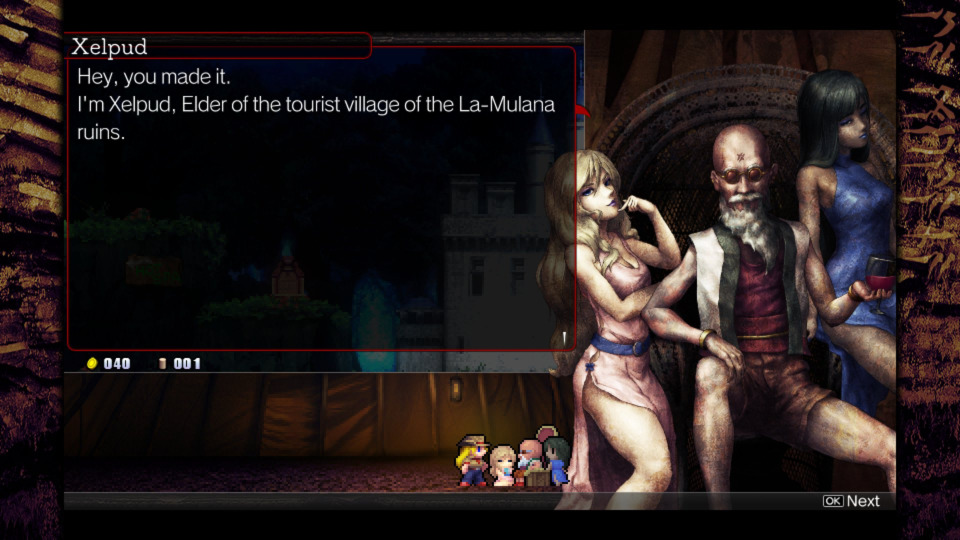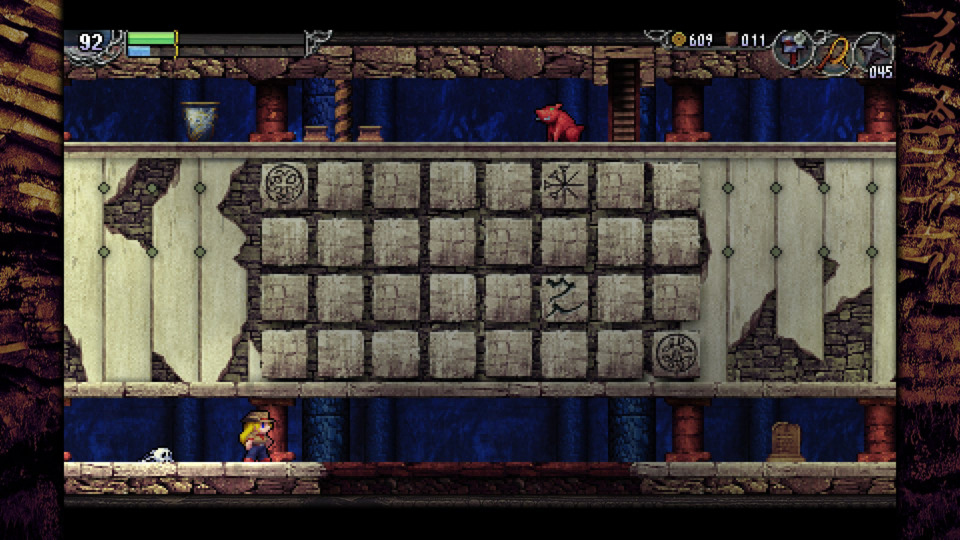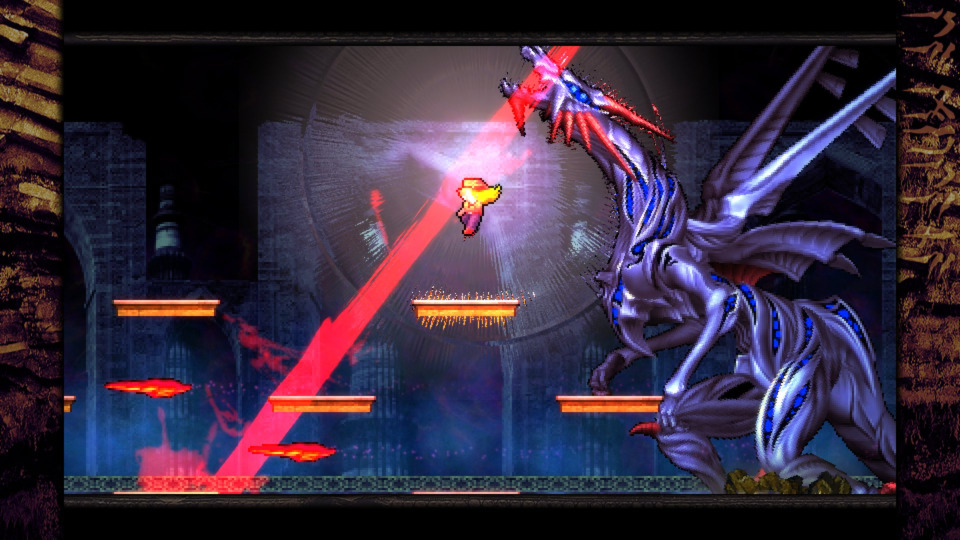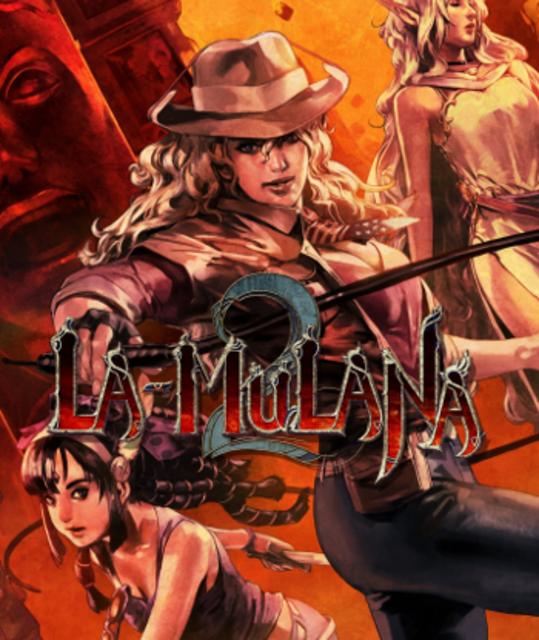
You know me, I love my explormers. The ever-reliable joys of 2D platforming married to a compelling sense of exploration and discovery, where taking notes like a goober is actually encouraged rather than considered overkill. Yet, sometimes you can have too much of a good thing: I never thought I'd get tired of hunting collectibles in 3D platformers, for instance, but even I have to admit that maybe Donkey Kong 64 overdid it. The first La-Mulana, between its Fez-esque (Fezque?) deeply complex puzzles that requires consulting several pages of hints and scouring every tile for secrets along with some extremely punitive traps and hazards that could instantly blip away any progress you'd made like Thanos clicking his fingers, was a game I bounced off faster than you can say, "Huh, what does this lever do?". Despite that, and with no indications La-Mulana 2 was going to take it easier on me - probably the opposite, given it's a sequel - I took a chance on Nigoro's 2018 archaeological adventure follow-up to see if this would be the time I could crack the franchise's otherwise impenetrable shell.
I think the sequel's first smart move was a much gentler on-boarding process helped in part by the almost immediate recovery of a fast-travel item that could be used anywhere. Fast-travel isn't necessarily something that makes a game easier, as it means bailing on your current position in the dungeon to regroup and retrace your steps, but knowing that - at any time - I could be tumbling down a spike pit with my health bar in the red and all I'd need to do is hit the map screen, warp my ass out of there, and go sit in the hub village's hot spring for a few seconds to health back to full is deeply reassuring, not least of all because it means not having to scrap any progress I might have made besides the purely geographic. Having this lifeline also means the game can get as justifiably cruel as it likes: I've only seen a few instant death traps, but the amount of times I've walked over some innocuous floor tile to get dropped two rooms down onto spikes can be counted in two digits now. Deaths, meanwhile, have long since climbed to the triple digits: this is not a game eager to take things easy on you, convenient warping aside.

The prologue, meanwhile, takes you through some of the events of the previous game: the titular La-Mulana dungeon is in ruins due to that game's protagonist Lemeza Kosugi (who is the father of La-Mulana 2's protagonist Lumisa Kosugi in a neat but probably coincidental parallel to another tough fedoras-and-whips platformer Spelunky 2) defeating the mother of all load-bearing bosses. However, it turns out La-Mulana has a darker secret side called Eg-Lana that is kind of the Isla Sorna to La-Mulana's Isla Nublar in that many of the first game's monsters originated there, with their La-Mulana versions being weaker copies. As La-Mulana is starting to fill with monsters again and the Elder of the nearby surface village is concerned about what this might mean for the area's booming tourism trade, Lumisa is called in to investigate the ruins after her father, the most obvious candidate for this mission, vanishes while exploring. In the first hour of the game, when you're poking through the ruins of La-Mulana and talking to critical NPCs about how the game ticks, the only enemies you're likely to meet are bats: annoying, especially if they decide to fly past in the middle of a jump, but far from life-threatening. By the time Eg-Lana has opened up to you and you're well out of the frying pan and into the fire, you'll have many of the tools and information you'll need and the controls down pat.
By most metrics, La-Mulana is a by-the-numbers 2D explormer in that you're running around a dungeon taking notes on areas and treasures that are currently inaccessible until you have the correct upgrades to reach them. The protagonist has a set of "main" weapons, which tend to be infinite-use melee weapons like the default whip, and "secondary" weapons which include various types of projectile. Separate to those are a set of non-combat usable items that can be equipped to the remaining face button (the others used for main weapons, secondary weapons, and jumping, respectively) and include the ever-useful hand-scanner, with which you'll procure the majority of the clues and hints from scanning dungeon backgrounds, glowing tablets, and NPC decedents holding onto their final message scraps (where most of the game's humor comes from, incongruously enough). Another odd quirk of the game's inventory system, owing to how the original was deliberately fashioned on MSX dungeon-crawlers like The Maze of Galious, is that you have an electronic tablet device that can hold a limited number of apps: these apps range from information-gathering tools like translators for some of the hint stones or a glossary for enemies and NPCs you've encountered, to the rarer mechanically-useful ones like one that reveals boss health bars and another that opens up a set of otherwise inaccessible fast-travel points.

The game is much more complex in structure than it originally lets on, however, with a vast amount of information thrown your way that you're expected to remember (or keep track of with another app) and deciphering these hints is often required for progress. The traps are also endless: as well as the obvious spikes and slightly less obvious crushers (spikes always remove 12.5% of your total health, while the crushers do 100%), there are blue and red glowing eyes that indicate that the current room has a puzzle to solve: if you don't solve the puzzle and close them, they'll zap you for an insane amount of harm if you as much as look at any of the murals in the room funny. On the other hand, pushing and whipping every inch of wall to find secrets is a necessity the game imparts to you very early on. Like any explormer, you'll want to keep notes on anything that looks like it might need an upgrade or key item to invoke: there's precious few boons offered to you beyond the occasional HP-Up orb and shop items start to get prohibitively expensive if you're not grabbing as much loot as possible. You just have to balance your larceny with the right amount of respect to those damn all-seeing eyes; it's much like the altars in NetHack (or Spelunky for that matter) and how desecrating them is rarely a good idea.
I will admit to one minor tactical error on my part that made my early going with the game far more challenging than it was meant to be. When you first enter Eg-Lana it's in an area referred to as Yggdrasil's Roots - Norse legend looms large in La-Mulana 2, but it's far from the only world mythology invoked - that splits off into at least five other zones. However, I missed a subtle route into the south area of the map where the first two dungeon areas you're meant to visit are located: instead, I focused on the top three routes, two of which required specific items to access. The third had a really tough dragon boss, Nidhogg, that I eventually managed to beat through sheer grit and grace, with perhaps a lot more of the former than the latter. The dungeon area he was guarding was one filled with lava and poisonous water (and poisonous lava too, it should be noted, which kills you in a matter of frames) that I was completely unprepared for; I spent a good five hours trying to make very incremental progress in here, taking notes on everywhere that was either impassable without the right gear or just way too intense to deal with. The odd thing is, I never questioned this sudden and dramatic rise in difficulty: having known about La-Mulana 2's ghoulish reputation and seeing the cruelty of the original game firsthand, I just figured that this meant the training wheels were off and the "true" La-Mulana had made itself known. Since eventually poking around a little further and finding the actual critical path, the game's been considerably easier than I was making it out to be. Not so easy that I'm not dying to dumb mistakes on a constant basis, but a lot closer towards the realm of the eminently doable. Of course, I'm not discounting the possibility that the actual true La-Mulana 2 has yet to appear.

Either way, I'm now hooked on this game in perhaps admittedly a Stockholm Syndrome-y type of way, devouring every snippet of lore and unusual iconography in case any of it becomes important later. This series has finally clicked with me thanks to the early-game accessibility of this sequel being all the run up I needed, in much the same way I was eventually able to grok Falcom's Zwei games via its more affable second incarnation, and even though sources suggest I'm in for a very long haul - HowLongToBeat clocks the game at something like 60 hours, and given the ordeals I've already been through and the number of empty slots I see on the inventory page I can very much believe it - I'm psyched to be on this franchise's wavelength, at long last. Time will tell if I'm able to stay there.
Rating: 4 out of 5. (So far.)
| < Back to 274: Raji: An Ancient Epic | The First 100 | The Second 100 | > Forward to 276: HoloCure: Save the Fans! |

Log in to comment